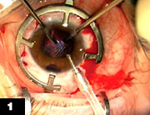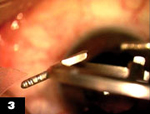Ring allows silicone oil removal through the limbus
Silicone oil removal through a pars plana sclerotomy is not as simple as usually thought and can be dangerous. Silicone oil tamponade is often employed in cases of complicated retinal detachment. In these cases, the retina can be retracted or detached in the periphery; scleral buckling and scleral thinning could be present in some areas. Every sclerotomy site must be carefully chosen, and sometimes the pars plana must be explored with indirect ophthalmoscopy and by scleral depression. But even in the simplest cases, retinal breaks and detachments may occur. So it is better to remove silicone oil through a limbal or corneal paracentesis whenever possible.
But what about other surgical maneuvers required after silicone oil removal? Silicone oil emulsification is present in every case, and every effort must be taken to reduce the number of silicone oil droplets in the vitreous cavity. Several fluid-air exchanges or better F6H8 injections, which can dissolve silicone oil remnants, have to be performed. Sometimes epiretinal membrane peeling, peripheral cryopexy or laser and scleral depression also have to be done in order to examine peripheral retina. These surgical maneuvers require good visualization of the fundus, and the surgeon can have a lot of trouble with that when the instruments are placed at the limbus instead of in pars plana.
Both conventional vitrectomy contact lenses and conventional lens-supporting rings cover almost the whole limbus. In order to clear the limbus, the smallest lenses must be used, but the surgeon also has to remove the silicone supporting ring. Without the ring, the lens floats over the cornea, displaces itself and falls with every motion of the eye. It is also difficult to do this with the binocular indirect ophthalmomicroscope because the movements of instruments are limited by the lens of the system. This can be done with the binocular indirect ophthalmoscope, but it requires a lot of skill.
New ring
In order to solve this problem, I designed a lens-supporting ring larger than a conventional one. The ring has an inner diameter of 13 mm, which allows access to the limbus. It has four fingers extending toward the center of the cornea that hold small contact lenses (usually used with silicone rings). The fingers are shaped to follow the curvature of the cornea and have a central thickening that fits the step in the contact lens. The ring is interrupted in one quadrant to accommodate an anterior chamber maintainer.
 The ring has an inner diameter larger than the standard ring in order to clear the limbus for the passage of the instruments. The ring is interrupted in one quadrant to accommodate an anterior chamber maintainer. |  The ring has four fingers that extend toward the center of the cornea in order to hold small contact lenses. |  The fingers, shaped to follow the curvature of the cornea, have a central thickening that fits the step in the contact lens. Images courtesy of Patrizio Seidenari, MD. |
Surgical technique
With this device, silicone oil removal and the aforementioned surgical maneuvers can be performed without great difficulty. An anterior chamber maintainer is placed in the inferotemporal region of the cornea in order to provide fluid infusion; then, the ring is sutured to the conjunctiva with the interrupted part matching the area of the anterior chamber maintainer. Two small, 20-gauge openings, through which various instruments such as vitreous cutters, light probes, flute needles and forceps can be introduced, are made in clear cornea near the limbus. The fundus can be visualized with the contact lens kept in place by the ring. The slit lamp can be used instead of the standard light probe in order to spare one sclerotomy.
The surgeon can also use this ring and operate through the clear cornea in pseudophakic eyes, passing through the peripheral part of the capsule. Besides silicone oil removal, this ring can be used in aphakic and pseudophakic eyes every time the surgeon wants to perform vitreoretinal surgery without passing through the pars plana.
This device is also useful when cataract surgery goes wrong, the posterior capsule is broken and nuclear particles are lost in the vitreous. If this happens, especially when a peribulbar anesthesia was not used, the surgeon does not like opening the conjunctiva and performing a standard pars plana procedure. With this ring and an anterior chamber maintainer, a complete vitrectomy can be performed through the clear cornea. Nuclear particles dropped on the posterior pole can be rescued and removed with phacoemulsification, and if necessary, the peripheral retina can be checked and treated.
This ring can also be used if there is a penetrating eye injury, the crystalline lens is lost, the vitreous is filled with blood or a retinal detachment is suspected.
For Your Information:
- Patrizio Seidenari, MD, can be reached at Ospedale Fatebenefratelli Oftalmico, Piazza Principessa Clotilde, Milano, Italy; +39-026-363-2258. Dr. Seidenari has no direct financial interest in the products mentioned in this article, nor is he a paid consultant for any companies mentioned.
- E. Janach srl, manufacturer of the ring, can be reached at Via Borgo Vico 35, 22100 Como, Italy; +39-031-574-088; fax: +39-031-572-055; e-mail: international@janach.it.
